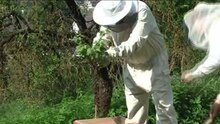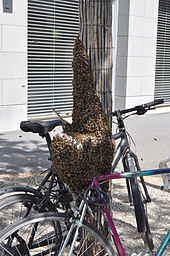Swarm instinct

Swarming means the natural, innate state of readiness of honeybees , their States to multiply by division. This urge to swarm is triggered by the growing strength of the bee colony in early summer (May – June), depending primarily on the space available and the supply of food.
The swarm (pre-swarm)
In early summer, a bee colony has the largest number of individuals in the course of the year. As a result, there are many nurse bees who want to care for brood, but can no longer find enough brood. This is the case, for example, if the dwelling is becoming too cramped. The bees then begin to build up to a dozen particularly large cells, known as queen cells . In the following days these cells are also pinned (the queen lays an egg in each). The developing larvae are fed exclusively with a special fodder juice produced by the nurse bees, royal jelly , and grow quickly to hatch as new queens on the 16th day after egg-laying . In the meantime the queen has stopped laying eggs (for the normal brood of bees) and has become slim and airworthy again.
On the ninth day after oviposition, or in bad weather at a subsequent leave suddenly, usually in the morning 11 to 12 indicator thousands of bees (10,000 or more) with their queen in a huge cloud of the hive . They later gather near the mother colony at one point as a swarm of grapes, for example in tree branches. There they take a break to orientate themselves further. Next, a few hundred trail bees will be sent out. These look for a suitable new nesting opportunity in the wider area, if possible a tree hole. If the search is unsuccessful, the whole swarm can rise up and fly on. The swarm gathers again at a second intermediate station . The investigation of a suitable nesting site then begins anew. These explorations scout bees always return to the flock and lead on the surface of the swarm to waggle on to other scouts to lure the newly discovered places.
This first swarm that arises in a colony willing to divide - with the old queen - is called the fore swarm.
Selection of the new nesting site
The transmission of information by the track bees in terms of direction and distance corresponds to that of the dance when transmitting a source of food. However, the more convinced they are of the location of the new nesting site, the more persistently they perform this dance. For example, a large, sheltered place is worth around 100 dances, whereas a mediocre place is only worth an average of twelve. In experiments by biologists at Cornell University in the US state of New York, it has been found that the waiting bee colony, willing to split up, begins to actively prepare for the move to the new nesting place as soon as about fifteen of the scouts have clearly spoken out in favor of a location . In such a decision-making process, in Seeley's opinion, the bees are not interested in a compromise , but in the best and fastest possible decision.
Swarms
In the backward mother colony , further swarms can emerge from the point in time at which the first new queen hatches . With every such swarm (secondary swarm) a young queen flies out. These swarms, too, initially gather near the old dwelling. When re-swarms leave, if several queens hatch at the same time, it can be so turbulent that there are even two or more young queens in the swarm that has gathered. Often, however, the swarms do not occur because the first-born young queen immediately sets out to kill her rivals who have not yet hatched. The beekeeper then speaks of having found bitten cells in the bee colony. In addition, a colony of bees does not divide for any length of time, because there is no longer sufficient bee mass.
After swarms are always much smaller than the fore swarms and can fly much further with the young queen.
Problem for beekeepers
The swarming instinct causes problems for today's beekeeper , who is mostly oriented towards early forage , as the swarming time falls into the main forage. Swarming colonies provide considerably less honey . The swarm instinct can, however, be dampened by breeding for swarm sluggishness and also by suitable beekeeping measures (operating mode), and swarming can even be prevented. It is now common practice to cup bee colonies before reaching the critical colony strength (which triggers the swarming instinct), i.e. to remove a certain number of bees with brood. So-called offshoots are then formed from this material (bees and honeycombs), which are initially set up outside the previous flight radius and provided with a queen cell that is ready to slip or a young queen that has already hatched.
On the other hand, a swarm captured by the beekeeper represents a new colony. If the beekeeper notices the start of swarming in time, he hangs a so-called swarm bag in front of the entrance hole and catches the swarm in it. When the queen is in the pouch, the rest of the swarm of bees collects partly outside, as can be seen in the picture.
Bee law
According to German bee law , the beekeeper retains ownership of the swarm as long as he follows it immediately. He may enter other people's properties. If the swarm finds a new empty hive, the owner of the swarming queen may open it to catch his bees. If the swarm moves into a floor that is already occupied, it belongs to the owner of the people who previously lived there. The owner of the moving swarm loses his rights.
history
In earlier beekeeping (such as heather beekeeping ) the bee colonies were increased by swarming. The aim here was to have as many swarms as possible early in the year in order to have many bees to bring in the late heather costume from August. The processed peoples were then killed with sulfur fumes for the honey harvest . In today's usual magazine mode , reproduction takes place through other targeted measures such as cupping, queen rearing and the formation of offshoots . Early swarming is disturbing.
In the meantime, however, there are also efforts to use the natural swarming instinct to multiply colonies of bees. A growing number of beekeepers are engaged in "essential beekeeping" -
See also
- Honeybees: swarming and looking for nesting sites
- Lorsch bee blessing
- Swarm intelligence
- Hungry swarm
Individual evidence
- ↑ Martin Lindauer: swarm bees looking for an apartment. In: Journal of Comparative Physiology . Vol. 37, No. 4, 1955, ISSN 1432-1351 , pp. 263-324, DOI: 10.1007 / BF00303153 .
- ↑ Thomas D. Seeley: bees democracy. How bees decide collectively and what we can learn from them . S. Fischer, Frankfurt am Main 2014, ISBN 978-3-10-075138-6 .
- ↑ § 961 BGB - single standard. Retrieved July 1, 2018 .
- ↑ § 962 BGB - single standard. Retrieved July 1, 2018 .
- ↑ § 964 BGB - single standard. Retrieved July 1, 2018 .
- ↑ https://www.mellifera.de/




